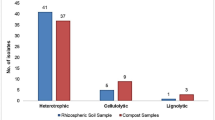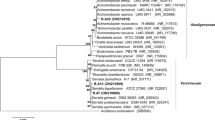Abstract
The aim of this study was to isolate and characterize bacteria from the compost of fruit and vegetable waste (FVW) for plant growth-promoting (PGP) activities and investigate the pro-active influence of bacterial isolates on wheat growth. Fourteen bacterial strains (RHC-1 to RHC-14) were isolated and purified in tryptic soya agar (TSA). In addition to being biochemically characterized, these bacterial strains were also tested for their PGP traits, such as phosphate (P)-solubilization, nifH gene amplification, indole-3-acetic acid (IAA) quantification and the production of ammonia, oxidase and catalase. Based on 16S rRNA gene sequencing, these bacterial strains were identified as belonging to species of Bacillus, Lysinibacillus, Lysobacter, Staphylococcus, Enterobacter, Pseudomonas and Serratia. All bacterial strains solubilized tri-calcium phosphate and produced IAA. Two bacterial strains RHC-8 (Enterobacter sp.) and RHC-13 (Pseudomonas sp.) solubilized the maximum amount of tri-calcium phosphate, i.e. 486 and 464 μg/ml, respectively. P-solubilization was associated with a significant drop in the pH of the broth culture from an initial pH of 7 to pH 4.43. In addition to P-solubilization and IAA production, six bacterial strains also carried the nifH gene and were further evaluated for their effect on wheat (Triticum aestivum) growth under controlled conditions. All six bacterial strains enhanced wheat growth as compared to uninoculated control plants. Two of the bacterial strains, RHC-8 and RHC-13, identified as Enterobacter aerogenes and Pseudomonas brenneri, respectively, were assessed as potential PGP rhizobacteria due to exhibiting characteristics of four or more PGP traits and enhancing wheat growth though their specific mechanism of action.
Similar content being viewed by others
References
Ahmed I, Yokota A, Fujiwara T (2007) A novel highly boron tolerant bacterium, Bacillus boronophilus sp. Nov., isolated from soil that require boron for its growth. Extremophiles 11:217–224
Akhtar MJ, Asghar HM, Shahzad K, Arshad M (2009) Role of plant growth promoting rhizobacteria applied in combination with compost and mineral fertilizers to improve growth and yield of wheat (Triticum aestivum). Pak J Bot 41:381–390
Banerjee MR, Yesmin L, Vessey JK (2006) Plant growth promoting rhizobacteria as biofertilizers and biopesticides. In: Rai MK (ed) Handbook of microbial biofertilizers. Food Products Press, New York, pp 137–181
Brick JM, Bostock RM, Silverstone SE (1991) Rapid in situ assay for indole acetic acid production by bacteria immobilized on nitrocellulose membrane. Appl Environ Microbiol 57:535–538
Çakmakçi R, Donmez F, Aydin A, Sahin F (2006) Growth promotion of plants by plant growth promoting rhizobacteria under greenhouse and two different field soil conditions. Soil Biol Biochem 38:1482–1487
Çakmakçi R, Erat M, Erdoğan ÜG, Dönmez MF (2007) The influence of PGPR on growth parameters, antioxidant and pentose phosphate oxidative cycle enzymes in wheat and spinach plants. J Plant Nutr Soil Sci 170:288–295
Cappuccino JC, Sherman N (2005) Microbiology. A laboratory manual. Wesley Publ. Co., New York
Chun J, Lee JH, Jung Y, Kim M, Kim S, Kim BK, Lim YW (2007) EzTaxon: a web-based tool for the identification of prokaryotes based on 16S ribosomal RNA gene sequences. Int J Syst Evol Microbiol 57:2259–2261
Cowan ST, Steel KJ (2004) Manual for the identification of medical bacteria, 3rd edn. Cambridge University Press, London
Gaur AC (1990) Physiological functions of phosphate solubilizing micro-organisms. In: Gaur AC (ed) Phosphate solubilizing micro-organisms as biofertilizers. Omega Scientific Publishers, New Delhi, pp 16–72
Goldstein AH (2007) Future trends in research on microbial phosphate solubilization: one hundred years of insolubility. In: Velázquez E, Rodríguez-Barrueco C (eds) First Int Meeting on Microbial Phosphate Solubilization. Springer, Dordrecht, pp 91–96
Hameeda B, Rupela OP, Reddy G, Satyavani K (2006) Application of plant growth-promoting bacteria associated with composts and macrofauna for growth promotion of Pearl millet (Pennisetum glaucum L.). Biol Fertil Soils 43:221–227
Hayat R, Ali S, Amara U, Khalid R, Ahmed I (2010) Soil beneficial bacteria and their role in plant growth promotion: a review. Ann Microbiol 60:579–598
Hayat R, Ahmed I, Sheirdil RI (2012) An overview of plant growth promoting rhizobacteria (PGPR) for sustainable agriculture. In: Ashraf M, Öztürk M, Ahmad MSA, Aksoy A (eds) Crop Production for Agricultural Improvement, part 3. Springer, Dordrecht, pp 557–579
Herman MAB, Nault BA, Smart CD (2008) Effects of plant growth promoting rhizobacteria on bell pepper production and green peach aphid infestation in New York. Crop Prot 27:996–1002
Illmer P, Schinner F (1992) Solubilization of inorganic phosphates by microorganisms isolated from forest soil. Soil Biol Biochem 24:389–395
Katsivela E, Bonse D, Kruger A, Strompl C, Livingston A, Ittich RM (1999) An extractive membrane biofilm reactor for degradation of 1,3-dichloropropene in industrial wastewater. Appl Microbiol Biotechnol 52:853–862
Khan MS, Zaidi A, Wani PA, Ahemad M, Oves M (2009) Functional diversity among plant growth-promoting rhizobacteria. In: Khan MS, Zaidi A, Musarrat J (eds) Microbial strategies for crop improvement. Springer, Berlin Heidelberg, pp 105–132
Kim KY, Jordan D, McDonald GA (1998) Enterobacter agglomerans, phosphate solubilizing bacteria, and microbial activity in soil: effect of carbon sources. Soil Biol Biochem 30:995–1003
Kishore GK, Pande S, Podile AR (2005) Biological control of late leaf spot of peanut (Arachis hypogaea L.) with chitinolytic bacteria. Phytopathology 95:1157–1165
Manici LM, Caputo F, Babibi V (2004) Effect of green manure on Pythium spp. population and microbial communities in intensive cropping systems. Plant Soil 263:133–142
Pikovskaya RI (1948) Mobilization of phosphorus in soil connection with the vital activity of some microbial species. Microbiolgiya 17:362–370
Rodríguez H, Fraga R, Gonzalez T, Bashan T (2006) Genetics of phosphate solubilization and its potential applications for improving plant growth-promoting bacteria. Plant Soil 287:15–21
Soultanpour PN, Workman SM (1979) Modification of the NH4HCO3-DTPA soil test to omit carbon black. Commun Soil Sci Plant Anal 10:1411–1420
Steel RGD, Torrie JH, Boston MA (1997) Principles and procedures of statistics: a biometrical approach. McGraw–Hill, New York
Tamura K, Dudley J, Nei M, Kumar S (2007) MEGA4: Molecular Evolutionary Genetics Analysis (MEGA) software version 4.0. Mol Biol Evol 24:1596–1599
Tye AJ, Siu FK, Leung TY, Lim BL (2002) Molecular cloning and the biochemical characterization of two novel phytases from Bacillus subtilis 168 and Bacillus licheniformis. Appl Microbiol Biotechnol 59:190–197
Vessey JK (2003) Plant growth promoting rhizobacteria as biofertilizers. Plant Soil 255:571–586
Watanabe FS, Olsen SR (1965) Test of an ascorbic acid method for determining phosphorus in water and NaHCO3 extracts from soil. Soil Sci Soc Am Proc 29:677–678
Yazdani M, Bahmanyar MA, Pirdashti H, Esmaili MA (2009) Effect of Phosphate solubilization microorganisms (PSM) and plant growth promoting rhizobacteria (PGPR) on yield and yield components of Corn (Zea mays L.). Proc World Acad Sci Eng Tech 37:90–92
Yu X, Liu X, Zhu TH, Liu GH, Mao C (2011) Isolation and characterization of phosphate-solubilizing bacteria from walnut and their effect on growth and phosphorus mobilization. Biol Fert Soils 47:437–446
Acknowledgments
Financial assistance from PMAS-Arid Agriculture University, Rawalpindi under the project entitled Preparation of Biofertilizer for Improving Legume N2-Fixation and Soil Health is highly acknowledged. DNA studies were carried out at the Plant Biotechnology Program, National Institute for Genomics and Advanced Biotechnology (NIGAB), National Agricultural Research Center (NARC), Islamabad, Pakistan. Bacterial strains were commercially sequenced with funding from the Pakistan Science Foundation project no. PSF-UAAR/Agr-374.
Author information
Authors and Affiliations
Corresponding author
Rights and permissions
About this article
Cite this article
Hayat, R., Sheirdil, R.A., Iftikhar-ul-Hassan, M. et al. Characterization and identification of compost bacteria based on 16S rRNA gene sequencing. Ann Microbiol 63, 905–912 (2013). https://doi.org/10.1007/s13213-012-0542-4
Received:
Accepted:
Published:
Issue Date:
DOI: https://doi.org/10.1007/s13213-012-0542-4




